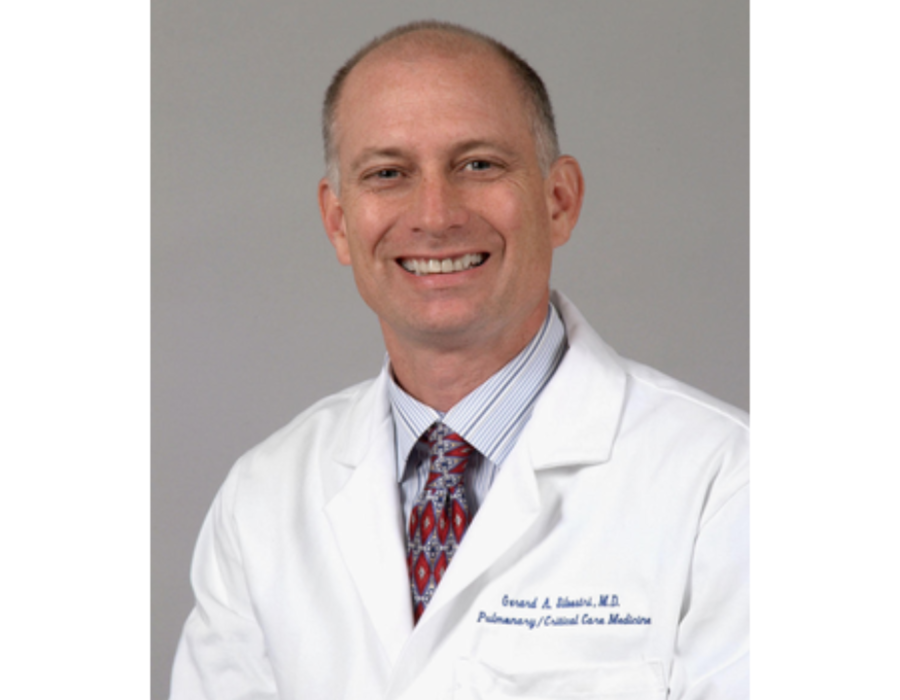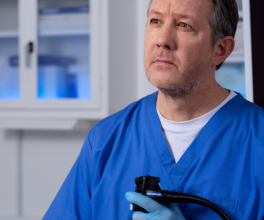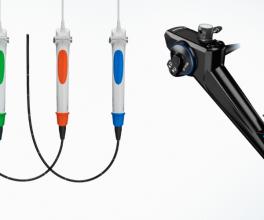
Killer Stats: Thoracic Oncologist Speaks to Olympus About Lung Cancer Screening, Disparities (Part 1)
It’s not a new message, but it’s a stark one: Smoking is an irrefutable killer. As the main cause of small cell and non-small cell lung cancer, it is responsible for 80% (women) to 90% (men) of lung cancer deaths.1 Gerard A. Silvestri, MD, MS, Hillenbrand Professor in Thoracic Oncology at the Medical University of South Carolina in Charleston, cited these statistics in a recorded presentation for Olympus staff on August 2, 2022. As a society, Dr. Silvestri noted that we can prevent lung cancer, or at least catch it at an earlier—and more treatable—stage through screening. He took a deep dive into the evidence supporting U.S. Preventive Services Task Force (USPSTF) screening guidelines,2 and the disparate uptake in underserved populations.
Guidelines backed by solid evidence
Current USPSTF screening guidelines recommend annual lung cancer screening for adults 50 to 80 years of age who have a 20 pack-year smoking history and currently smoke or had smoked in the past 15 years.2 Screening is done with low-dose computed tomography (LDCT). “We just had the [USPSTF] update our recommendations,” in March 2021, noted Dr. Silvestri. The previous guidelines, released in 2013, were backed by the National Lung Screening Trial (NLST)3 supporting screening in people 55 to 74 years of age with a 30 pack-year history.
“The [NLST] is the largest trial in the United States,” Dr. Silvestri stated. “They randomized 53,000 people to either get a CT scan or a chest X-ray.” Participants in the trial who were screened with LDCT had a 15 to 20% reduced chance of dying from lung cancer compared to those screened with a chest X-ray.3

Gerard A. Silvestri, MD, MS
The ‘sweet spot’ of early detection, early treatment
The USPSTF expanded the screening age to 80 based on a review of additional data, which included the NELSON trial.4 “The NELSON trial actually dropped the age to 50 [to begin screening] … and [people] had to quit [smoking] within the last 10 years,” Dr. Silvestri explained. He noted that trial was a randomized controlled trial limited to four sites with scans done at one, three, and five-and-a-half years.4 “The data generated from this trial found that those down to age 50 with a 20 pack-year history of smoking also received a mortality benefit. This added another 6.5 million people eligible for screening in the United States alone,” he explained. “We already had 8 million, so now [almost] 15 million people are eligible for screening.”4
In casting this wider net, “They picked up a higher proportion of later stage disease when the interval between screens was two-and-a-half years as opposed [to] one year, which was a good thing for understanding screening, because now we know that we have to screen every year,” Dr. Silvestri said of the NELSON trial results.4
“The great news is what we want to see from screening is a stage shift. That is, you want to go from diagnosing late-stage disease when patients show up symptomatic in your office to earlier stage disease,” explained Dr. Silvestri.
It remains to be seen how the updated guidelines will bear this out. The previous guidelines uncovered demographics on who was screened, based on the American College of Radiology registry data that Dr. Silvestri’s lab analyzed on the first 1 million screened since the original guidelines went into effect:5
- More women were screened
- More older people (65 to 74 years of age) were screened
- About the appropriate number of African Americans were screened at 7.4%
- A low number of Hispanics—40% less than expected—were screened
- More current smokers—17%—were screened
Researchers concluded that men, those who formerly smoked, and younger eligible patients may be less likely to be screened. In addition, adherence to annual follow-up screening was poor, potentially limiting screening effectiveness.5
One observation you could make of the initial guidelines is that it included the “worried well,” as Dr. Silvestri put it. He reviewed a number of studies outside of this demographic to better understand how the larger population may be impacted by the expanded screening guidelines, but ultimately, he emphasized that time will tell if researchers have found “the sweet spot” in terms of targeting the appropriate candidates to be screened, without over-screening those who have too many comorbidities (multiple medical conditions) for screening to be beneficial.6,7
Missing the mark, by state
Depending on where you live, access to screening may vary, noted Dr. Silvestri. He referenced a U.S. map that plotted these locations.7 “You can’t get through New York City without tripping over a CT screener every block, and Florida is really just an annex of New York,” he joked. “But if you look at the South, and particularly in the West, other than California, you don’t see much.” Dr. Silvestri was a contributing author in this study in which researchers determined that states with the highest lung cancer burden have the least amount of screening centers.7
“Nevada, which has the lowest percentage of people being screened, has one of the highest burdens of lung cancer in the U.S. What we see is a poor distribution of screening sites in areas where they need them,” Dr. Silvestri concluded. “But if you build it, they will come,” he added. “Vermont and New Hampshire have high screening rates. But their burden of cancer is actually not that high. So, we aren’t matching our resources with our need to screen where the people at the highest risk live.”7
Who smokes?
It bears repeating that smokers are considered high risk.1
“If you were going to create a disadvantaged population, it would start with the simple fact that you are pursuing a population that smokes,” said Dr. Silvestri. Unlike breast or colorectal cancer screening, Dr. Silvestri observed that, “This is the first time we’re going to be aiming our screening services towards a population with a particularly poor health habit.”
Currently, about 15% of the U.S. population smokes.9 And based on their profile, this group trends toward:9
- Low education
- Mental illness
- Under or uninsured
- Low income
- Native American
- LGBTQ
- Veterans
“These folks have poor access to service,” Dr. Silvestri stated.
Moving the needle
Overall, Dr. Silvestri said that screening is increasing, but it’s happening slowly. Outreach efforts can help in places like local churches, as well as enlisting “champions” and public service announcements. In addition, “We need to educate providers with referring tools designed to make the referral and eligibility confirmation easier,” Dr. Silvestri added. “For breast and colorectal cancers, it’s very easy—you’re this age, you get screened. For lung cancer, you have to figure out how many years [a patient] smoked, what their pack years were, and if they quit, when they quit,” to determine insurance eligibility.
Compliance is also important, noted Dr. Silvestri. “We really need to get people to come back [for follow-up screening]. One of the things we’re doing in South Carolina is opening up screening programs in rural and underserved communities,” he added. “We just got some funding for a CT bus” similar to a mammography bus they used for breast cancer screening. Overall, he stated, “We need to look at system level changes here.”
Dr. Silvestri is a paid consultant of the Olympus Corporation, its subsidiaries and/or its affiliates.
Olympus Corporation of the Americas and its parents, subsidiaries, affiliates, directors, officers, employees, agents, and representatives (collectively “Olympus”) do not represent to or warrant the accuracy, reliability, or applicability of the Case Study.
References
1. U.S. Department of Health and Human Services. The Health Consequences of Smoking: A Report of the Surgeon General. 2004. Accessed October 24, 2022.
2. U.S. Preventive Services Task Force. Accessed September 29, 2022. https://www.uspreventiveservicestaskforce.org/uspstf/recommendation/lung-cancer-screening#:~:text=Recommendation%20Summary&text=The%20USPSTF%20recommends%20annual%20screening,within%20the%20past%2015%20years
3. National Lung Screening Trial Research Team, Aberle DR, Adams AM, et al. Reduced lung-cancer mortality with low-dose computed tomographic screening. N Engl J Med. 2011;365(5):395-409.
4. de Koning HJ, van der Aalst CM, de Jong PA, et al. Reduced Lung-Cancer Mortality with Volume CT Screening in a Randomized Trial. N Engl J Med. 2020;382(6):503-513.
5. Silvestri GA, Goldman L, Burleson J, et al. Characteristics of persons screened for lung cancer in the United States: A cohort study [published online ahead of print, 2022 Oct 11]. Ann Intern Med. 2022;10.7326/M22-1325.
6. Tanner N, Dai L, Bade B. et al. Assessing the generalizability of the National Lung Screening Trial: Comparison of patients with stage 1 disease. Am J Respir Crit Care Med. 2017 Sept 1 96(5):602-608.
7. Howard DH, Richards TB, Bach PB, et al. Comorbidities, smoking status, and life expectancy among individuals eligible for lung cancer screening. Cancer. 2015;121(24):4341-4347.
8. Fedewa SA, Kazerooni EA, Studts JL, et al. State variation in low-dose computed tomography scanning for lung cancer screening in the United States. J Natl Cancer Inst. 2021;113(8):1044-1052.
9. Cornelius ME, Loretan CG, Wang TW, et al. Tobacco product use among adults--- United States, 2020. MMWR Morb Mortal Wkly Rep 2022;71:397-405.





